Unexpected Regional Zonal Structures in Low Latitude Ionosphere Call for a High Longitudinal Resolution of the Global Ionospheric Maps
Abstract
:1. Introduction
2. Materials and Methods
3. Results
3.1. Zonal Differences in TEC
3.1.1. 14–16 December (DOY 348–350) 2019
3.1.2. 14–16 March (DOY 74–76) 2020
3.2. General Overview for Longitudinal Differences of TEC Recorded at GDGZ in 2019–2020
4. Discussion
4.1. Patterns of Longitudinal Differences
4.2. Possible Contributors of Longitudinal Differences
4.3. Performance of GIMs
5. Conclusions
- (1)
- The GNSS TEC observations in 2019–2020 exhibit diverse longitudinal structures in the northern low-latitude ionosphere. Intense zonal differences may occur with highest TEC on the east or west side, regardless of geomagnetic activity conditions.
- (2)
- The strong zonal differences are clustered in a narrow zone. The zone is different case by case. The spatial extent of this phenomenon highlights that it is a new kind of spatial structure, not the extreme presentation of the large-scale longitudinal variations reported before.
- (3)
- There are evident and diverse zonal differences in the departures from the medians during the period of strong gradients. The features of the strong differences cannot be satisfactorily explained in terms of the local time effects of the diurnal variations of the ionosphere.
- (4)
- Strong zonal differences are absent in the conjugated region in the southern hemisphere in the two cases.
- (5)
- The regional scale longitudinal structures with strong differences challenge the presentation of the current GIMs. It suggests a finer spatial resolution being adopted in future products of GIMs.
Author Contributions
Funding
Data Availability Statement
Acknowledgments
Conflicts of Interest
References
- Schaer, S. Mapping and Predicting the Earths Ionosphere using the Global Positioning System. Ph.D. Thesis, University of Bern, Bern, Switzerland, 1999. [Google Scholar]
- Yue, X.; Schreiner, W.S.; Lei, J.; Sokolovskiy, S.V.; Rocken, C.; Hunt, D.C.; Kuo, Y.-H. Error analysis of Abel retrieved electron density profiles from radio occultation measurements. Ann. Geophys. 2010, 28, 217–222. [Google Scholar] [CrossRef] [Green Version]
- Yang, Y.; Liu, L.; Zhao, X.; Xie, H.; Chen, Y.; Le, H.; Zhang, R.; Tariq, M.A.; Li, W. Ionospheric Nighttime Enhancements at Low Latitudes Challenge Performance of the Global Ionospheric Maps. Remote Sens. 2022, 14, 1088. [Google Scholar] [CrossRef]
- Liu, L.; Chen, Y.; Le, H.; Ning, B.; Wan, W.; Liu, J.; Hu, L. A case study of postmidnight enhancement in F-layer electron density over Sanya of China. J. Geophys. Res. Space Phys. 2013, 118, 4640–4648. [Google Scholar] [CrossRef]
- Li, Z.; Wang, N.; Li, M.; Zhou, K.; Yuan, Y.B.; Yuan, H. Evaluation and analysis of the global ionospheric TEC map in the frame of international GNSS services. Chin. J. Geophys. 2017, 60, 3718–3729. [Google Scholar] [CrossRef]
- Liu, L.; Le, H.; Wan, W.; Sulzer, M.P.; Lei, J.; Zhang, M.-L. An analysis of the scale heights in the lower topside ionosphere based on the Arecibo incoherent scatter radar measurements. J. Geophys. Res. Space Phys. 2007, 112, A06307. [Google Scholar] [CrossRef] [Green Version]
- Heelis, R.A.; Coley, W.R. Variations in the low- and middle-latitude topside ion concentration observed by DMSP during superstorm events. J. Geophys. Res. 2007, 112, A08310. [Google Scholar] [CrossRef] [Green Version]
- Zhang, S.-R.; Foster, J.C.; Coster, A.J.; Erickson, P.J. East-West Coast differences in total electron content over the continental US. Geophys. Res. Lett. 2011, 38, L19101. [Google Scholar] [CrossRef] [Green Version]
- Zhang, S.-R.; Foster, J.C.; Holt, J.M.; Erickson, P.J.; Coster, A.J. Magnetic declination and zonal wind effects on longitudinal differences of ionospheric electron density at midlatitudes. J. Geophys. Res. Space Phys. 2012, 117, A08329. [Google Scholar] [CrossRef] [Green Version]
- Zhao, B.; Wang, M.; Wang, Y.; Ren, Z.; Yue, X.; Zhu, J.; Wan, W.; Ning, B.; Liu, J.; Xiong, B. East-west differences in F-region electron density at midlatitude: Evidence from the Far East region. J. Geophys. Res. Space Phys. 2013, 118, 542–553. [Google Scholar] [CrossRef]
- Xu, J.S.; Li, X.J.; Liu, Y.W.; Jing, M. TEC differences for the mid-latitude ionosphere in both sides of the longitudes with zero declination. Adv. Space Res. 2014, 54, 883–895. [Google Scholar] [CrossRef]
- Li, Q.; Liu, L.; Balan, N.; Huang, H.; Zhang, R.; Chen, Y.; Le, H. Longitudinal structure of the midlatitude ionosphere using COSMIC electron density profiles. J. Geophys. Res. Space Phys. 2018, 123, 8766–8777. [Google Scholar] [CrossRef]
- Xiong, C.; Lühr, H. The Midlatitude Summer Night Anomaly as observed by CHAMP and GRACE: Interpreted as tidal features. J. Geophys. Res. Space Phys. 2014, 119, 4905–4915. [Google Scholar] [CrossRef] [Green Version]
- Ma, H.; Liu, L.; Chen, Y.; Le, H.; Li, Q.; Zhang, H. Longitudinal differences in electron temperature on both sides of zero declination line in the mid-latitude topside ionosphere. J. Geophys. Res. Space Phys. 2021, 126, e2020JA028471. [Google Scholar] [CrossRef]
- Immel, T.J.; Sagawa, E.; England, S.L.; Henderson, S.B.; Hagan, M.E.; Mende, S.B.; Frey, H.U.; Swenson, C.M.; Paxton, L.J. Control of equatorial ionospheric morphology by atmospheric tides. Geophys. Res. Lett. 2006, 33, L15108. [Google Scholar] [CrossRef]
- Kil, H.; Lee, W.K.; Kwak, Y.-S.; Oh, S.-J.; Paxton, L.J.; Zhang, Y. Persistent longitudinal features in the low-latitude ionosphere. J. Geophys. Res. 2012, 117, A06315. [Google Scholar] [CrossRef] [Green Version]
- Wan, W.; Liu, L.; Pi, X.; Zhang, M.-L.; Ning, B.; Xiong, J.; Ding, F. Wavenumber-4 patterns of the total electron content over the low latitude ionosphere. Geophys. Res. Lett. 2008, 35, L12104. [Google Scholar] [CrossRef]
- Ren, Z.; Wan, W.; Liu, L.; Zhao, B.; Wei, Y.; Yue, X.; Heelis, R.A. Longitudinal variations of electron temperature and total ion density in the sunset equatorial topside ionosphere. Geophys. Res. Lett. 2008, 35, L05108. [Google Scholar] [CrossRef] [Green Version]
- Mendillo, M. Storms in the ionosphere: Patterns and processes for total electron content. Rev. Geophys. 2006, 44, RG4001. [Google Scholar] [CrossRef]
- Fagundes, P.R.; Cardoso, F.A.; Fejer, B.G.; Venkatesh, K.; Ribeiro, B.A.G.; Pillat, V.G. Positive and negative GPS-TEC ionospheric storm effects during the extreme space weather event of March 2015 over the Brazilian sector. J. Geophys. Res. Space Phys. 2016, 121, 5613–5625. [Google Scholar] [CrossRef] [Green Version]
- Liu, L.; Le, H.; Chen, Y.; Zhang, R.; Wan, W. New Aspects of the ionospheric behavior over Millstone Hill during the 30-day incoherent scatter radar experiment in October 2002. J. Geophys. Res. Space Phys. 2019, 124, 6288–6295. [Google Scholar] [CrossRef]
- Kuai, J.; Liu, L.; Liu, J.; Sripathi, S.; Zhao, B.; Chen, Y.; Le, H.; Hu, L. Effects of disturbed electric fields in the low-latitude and equatorial ionosphere during the 2015 St. Patrick’s Day storm. J. Geophys. Res. Space Phys. 2016, 121, 9111–9126. [Google Scholar] [CrossRef]
- Huang, F.; Lei, J.; Dou, X. Daytime ionospheric longitudinal gradients seen in the observations from a regional BeiDou GEO receiver network. J. Geophys. Res. Space Phys. 2017, 122, 6552–6561. [Google Scholar] [CrossRef]
- Liu, L.; Ding, Z.; Zhang, R.; Chen, Y.; Le, H.; Zhang, H.; Wu, J.; Wan, W. A case study of the enhancements in ionospheric electron density and its longitudinal gradient at Chinese low latitudes. J. Geophys. Res. Space Phys. 2020, 125, e2019JA027751. [Google Scholar] [CrossRef]
- Sunda, S.; Vyas, B.M. Local time, seasonal, and solar cycle dependency of longitudinal variations of TEC along the crest of EIA over India. J. Geophys. Res. Space Phys. 2013, 118, 6777–6785. [Google Scholar] [CrossRef]
- Vladimer, J.A.; Jastrzebski, P.; Lee, M.C.; Doherty, P.H.; Decker, D.T.; Anderson, D.N. Longitude structure of ionospheric total electron content at low latitudes measured by the TOPEX/Poseidon satellite. Radio Sci. 1999, 34, 1239–1260. [Google Scholar] [CrossRef] [Green Version]
- Sun, W.; Wu, B.; Wu, Z.; Hu, L.; Zhao, X.; Zheng, J.; Xie, H.; Yang, S.; Ning, B.; Li, G. IONISE: An ionospheric observational network for irregularity and scintillation in East and Southeast Asia. J. Geophys. Res. Space Phys. 2020, 125, e2020JA028055. [Google Scholar] [CrossRef]
- Hu, L.; Yue, X.; Ning, B. Development of the Beidou Ionospheric Observation Network in China for space weather monitoring. Space Weather 2017, 15, 974–984. [Google Scholar] [CrossRef]
- Yuan, Y.; Li, Z.; Wang, N.; Zhang, B.; Li, H.; Li, M.; Huo, X.; Ou, J. Monitoring the ionosphere based on the Crustal Movement Observation Network of China. Geod. Geodyn. 2015, 16, 73–80. [Google Scholar] [CrossRef] [Green Version]
- Aa, E.; Huang, W.; Yu, S.; Liu, S.; Shi, L.; Gong, J.; Chen, Y.; Shen, H. A regional ionospheric TEC mapping technique over China and adjacent areas on the basis of data assimilation. J. Geophys. Res. Space Phys. 2015, 120, 5049–5061. [Google Scholar] [CrossRef] [Green Version]
- She, C.; Yue, X.; Hu, L.; Zhang, F. Estimation of Ionospheric Total Electron Content from a Multi-GNSS Station in China. IEEE Trans. Geosci. Remote Sens. 2020, 58, 852–860. [Google Scholar] [CrossRef]
- Prol, F.D.S.; Camargo, P.D.O.; Monico, J.F.G.; Muella, D.A.H. Assessment of a TEC calibration procedure by single-frequency PPP. GPS Solut. 2018, 22, 35. [Google Scholar] [CrossRef] [Green Version]
- Rideout, W.; Coster, A. Automated GPS processing for global total electron content data. GPS Solut. 2006, 10, 219–228. [Google Scholar] [CrossRef]
- Mannucci, A.; Wilson, B.; Yuan, D.; Ho, C.; Lindqwister, U.; Runge, T. A global mapping technique for GPS-derived ionospheric total electron content measurements. Radio Sci. 1998, 33, 565–582. [Google Scholar] [CrossRef]
- Roma-Dollase, D.; Hernández-Pajares, M.; Krankowski, A.; Kotulak, K.; Ghoddousi-Fard, R.; Yuan, Y.; Li, Z.; Zhang, H.; Shi, C.; Wang, C.; et al. Consistency of seven different GNSS global ionospheric mapping techniques during one solar cycle. J. Geod. 2018, 92, 691–706. [Google Scholar] [CrossRef] [Green Version]
- Li, Z.; Wang, N.; Liu, A.; Yuan, Y.; Wang, L.; Hernández-Pajares, M.; Krankowski, A.; Yuan, H. Status of CAS global ionospheric maps after the maximum of solar cycle 24. Satell. Navig. 2021, 2, 19. [Google Scholar] [CrossRef]
- Komjathy, A.; Sparks, L.; Wilson, B.D.; Mannucci, A.J. Automated daily processing of more than 1000 ground-based GPS receivers for studying intense ionospheric storms. Radio Sci. 2005, 40, RS6006. [Google Scholar] [CrossRef] [Green Version]
- Hernandez-Pajares, M.; Juan, J.; Sanz, J. New approaches in global ionospheric determination using ground gps data. J. Atmos. Sol. Terr. Phys. 1999, 61, 1237–1247. [Google Scholar] [CrossRef]
- Nava, B.; Radicella, S.M.; Leitinger, R.; Coisson, P. Use of total electron content data to analyze ionosphere electron density gradients. Adv. Space Res. 2007, 39, 1292–1297. [Google Scholar] [CrossRef]
- Kim, J.; Lee, S.W.; Lee, H.K. An annual variation analysis of the ionospheric spatial gradient over a regional area for GNSS applications. Adv. Space Res. 2014, 54, 333–341. [Google Scholar] [CrossRef]
- Jakowski, N.; Stankov, S.M.; Schlueter, S.; Klaehn, D. On developing a new ionospheric perturbation index for space weather operations. Adv. Space Res. 2006, 38, 2596–2600. [Google Scholar] [CrossRef]
- Juan, J.M.; Sanz, J.; Rovira-Garcia, A.; González-Casado, G.; Ibáñez, D.; Perez, R.O. AATR an ionospheric activity indicator specifically based on GNSS measurements. J. Space Weather Space Clim. 2018, 8, A14. [Google Scholar] [CrossRef]
- Srinivas, V.S.; Sarma, A.D.; Reddy, A.S.; Reddy, D.K. Investigation of the Effect of Ionospheric Gradients on GPS Signals in the Context of LAAS. Prog. Electromagn. Res. B 2014, 57, 191–205. [Google Scholar] [CrossRef] [Green Version]
- Heelis, R.A.; Maute, A. Challenges to Understanding the Earth’s Ionosphere and Thermosphere. J. Geophys. Res. Space Phys. 2020, 125, e2019JA027497. [Google Scholar] [CrossRef]
- Klobuchar, J.A. Ionospheric time-delay algorithm for single-frequency GPS users. IEEE Trans. Aerosp. Electron. Syst. 1987, AES-23, 325–331. [Google Scholar] [CrossRef]
- Liu, L.B.; Chen, Y.D.; Zhang, R.L.; Le, H.J.; Zhang, H. Some investigations of ionospheric diurnal variation. Rev. Geophys. Planet. Phys. 2021, 52, 647–661. [Google Scholar] [CrossRef]
- Xiong, B.; Wan, W.; Yu, Y.; Hu, L. Investigation of ionospheric TEC over China based on GNSS data. Adv. Space Res. 2016, 58, 867–877. [Google Scholar] [CrossRef]
- Anderson, D.; Anghel, A.; Yumoto, K.; Ishitsuka, M.; Kudeki, E. Estimating daytime vertical ExB drift velocities in the equatorial F-region using ground-based magnetometer observations. Geophys. Res. Lett. 2002, 29, 1596. [Google Scholar] [CrossRef]
- Zhao, B.; Wan, W.; Liu, L.; Igarashi, K.; Nakamura, M.; Paxton, L.J.; Su, S.-Y.; Li, G.; Ren, Z. Anomalous enhancement of ionospheric electron content in the Asian-Australian region during a geomagnetically quiet day. J. Geophys. Res. 2008, 113, A11302. [Google Scholar] [CrossRef] [Green Version]
- Mukhtarov, P.; Pancheva, D.; Andonov, B.; Pashova, L. Global TEC maps based on GNSS data: 1. Empirical background TEC model. J. Geophys. Res. Space Phys. 2013, 118, 4594–4608. [Google Scholar] [CrossRef]
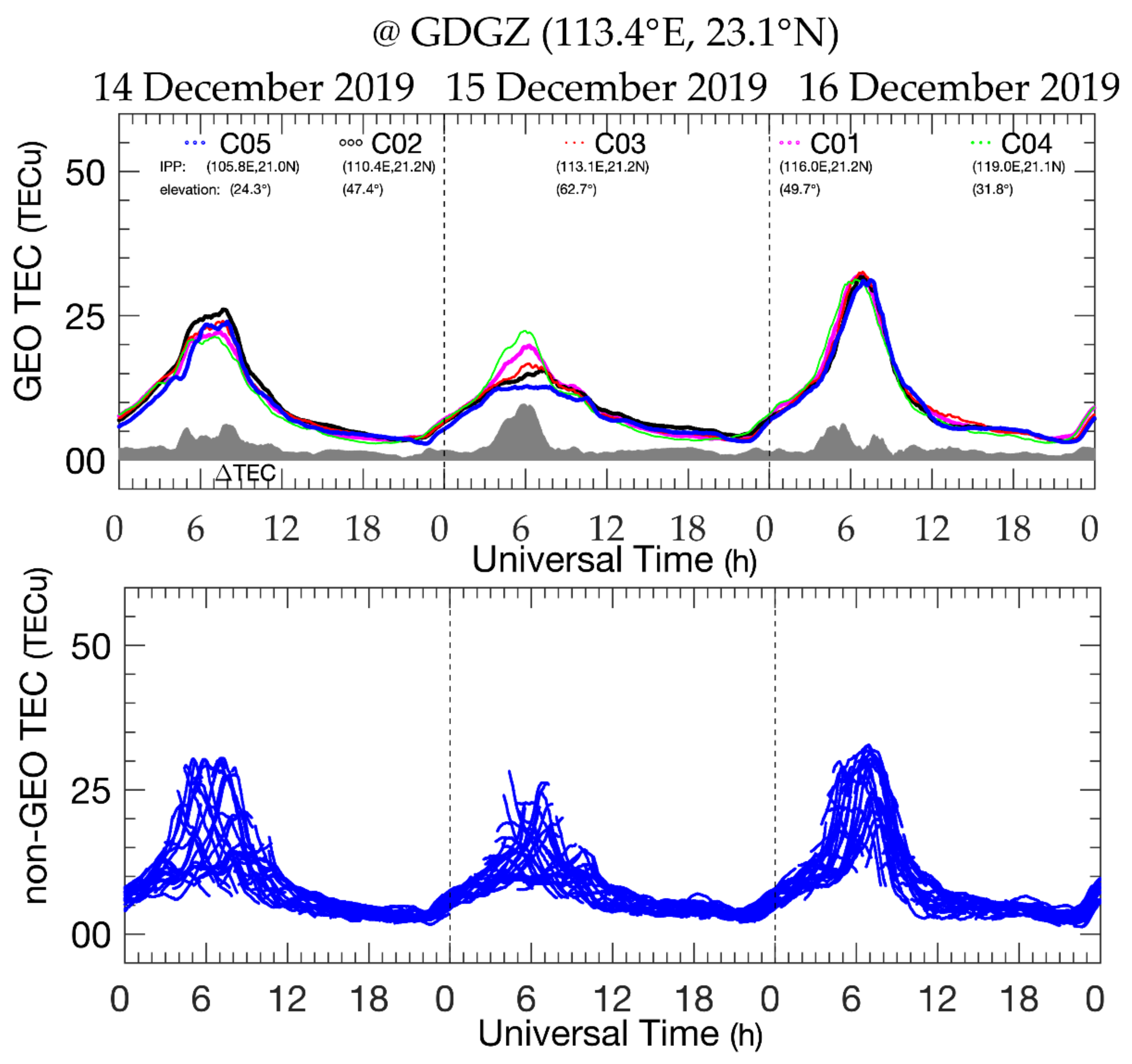
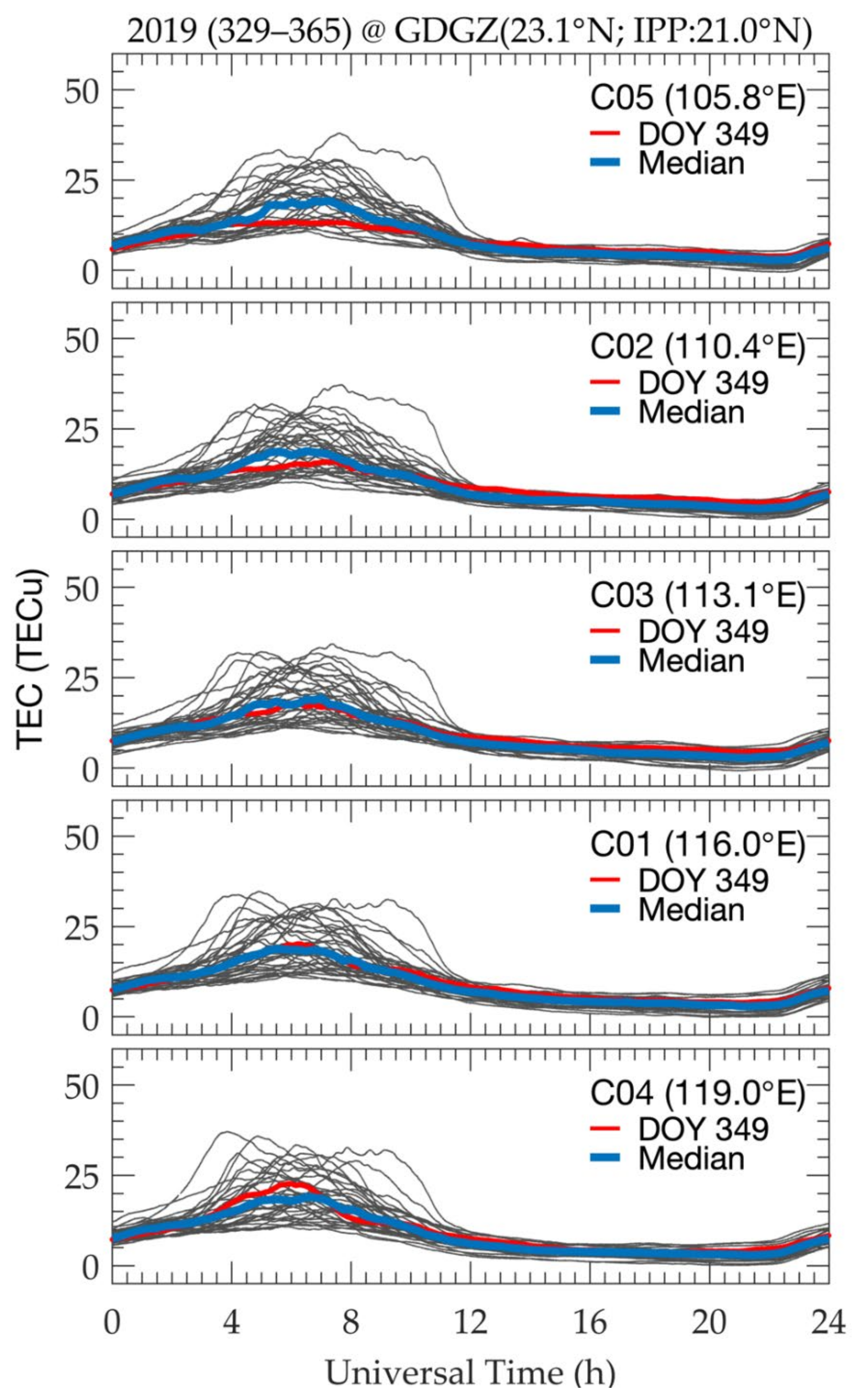
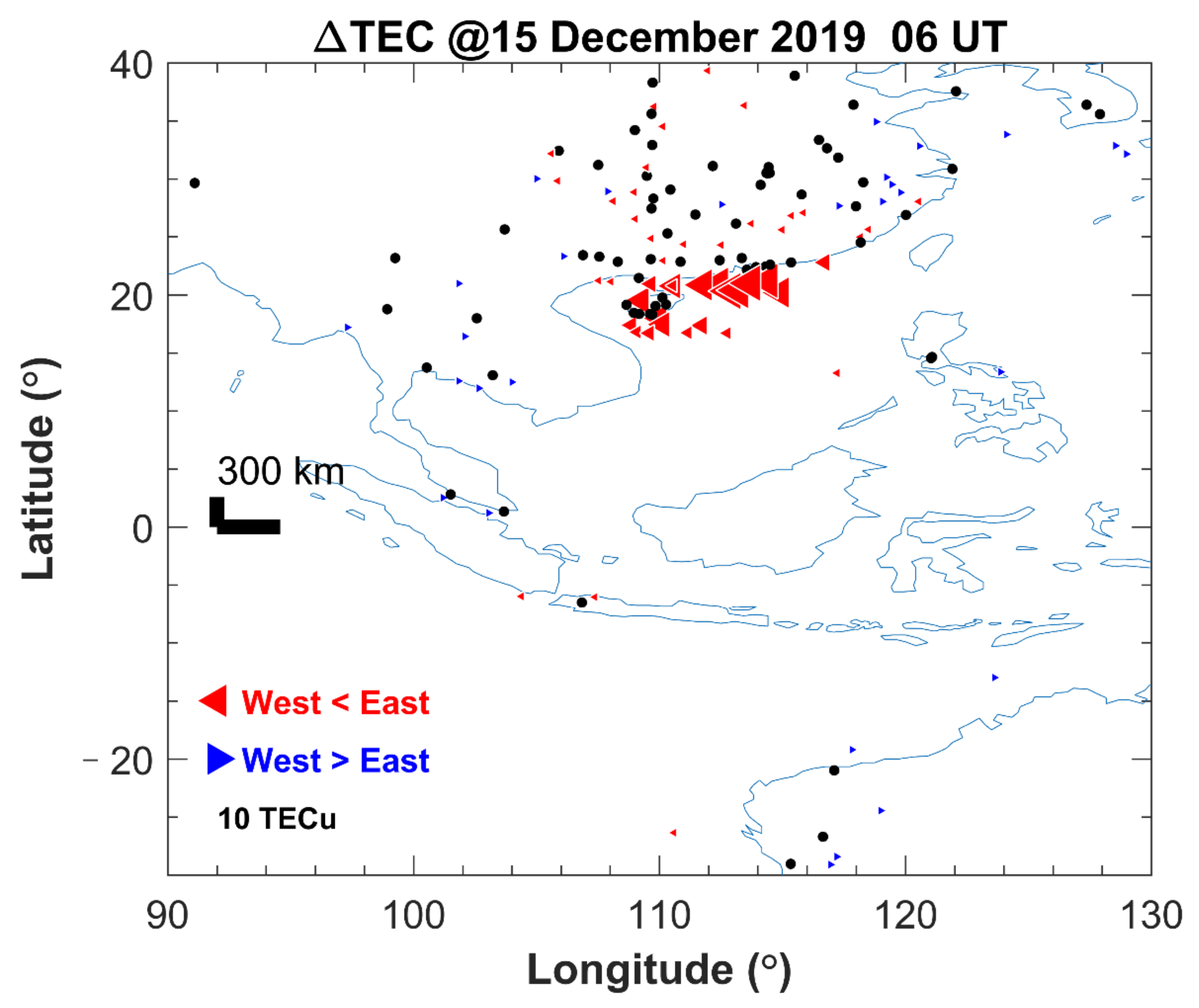
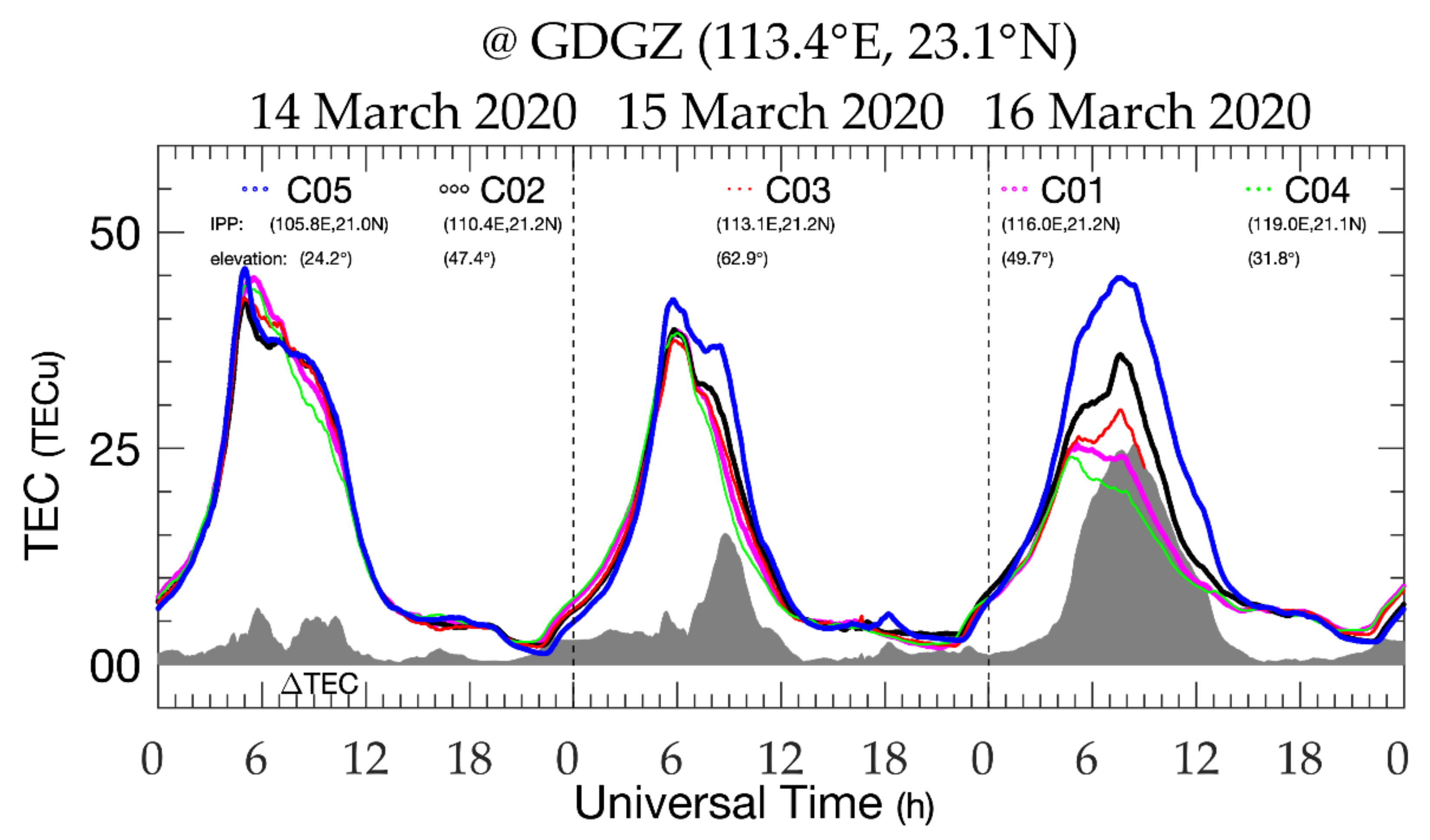

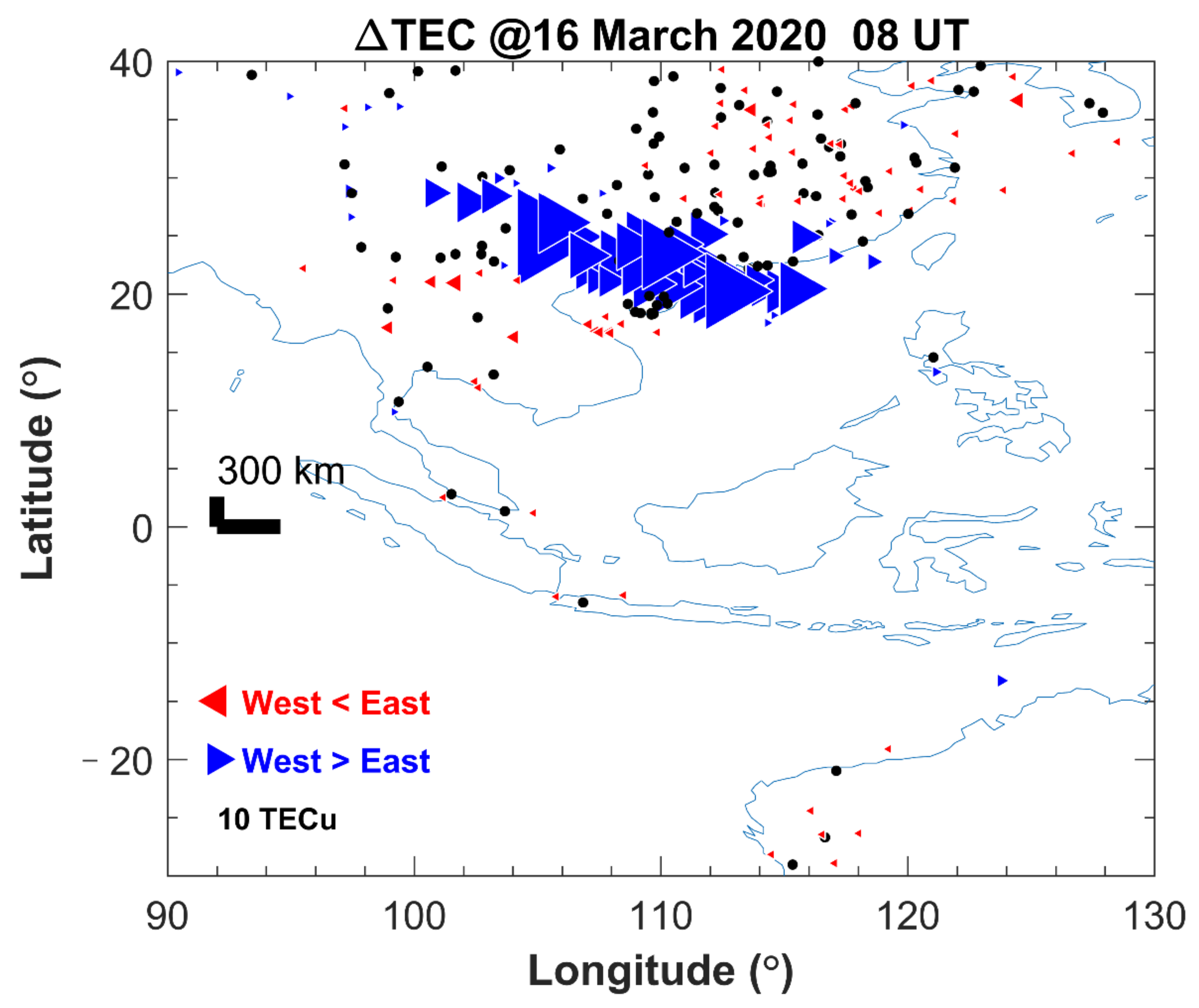
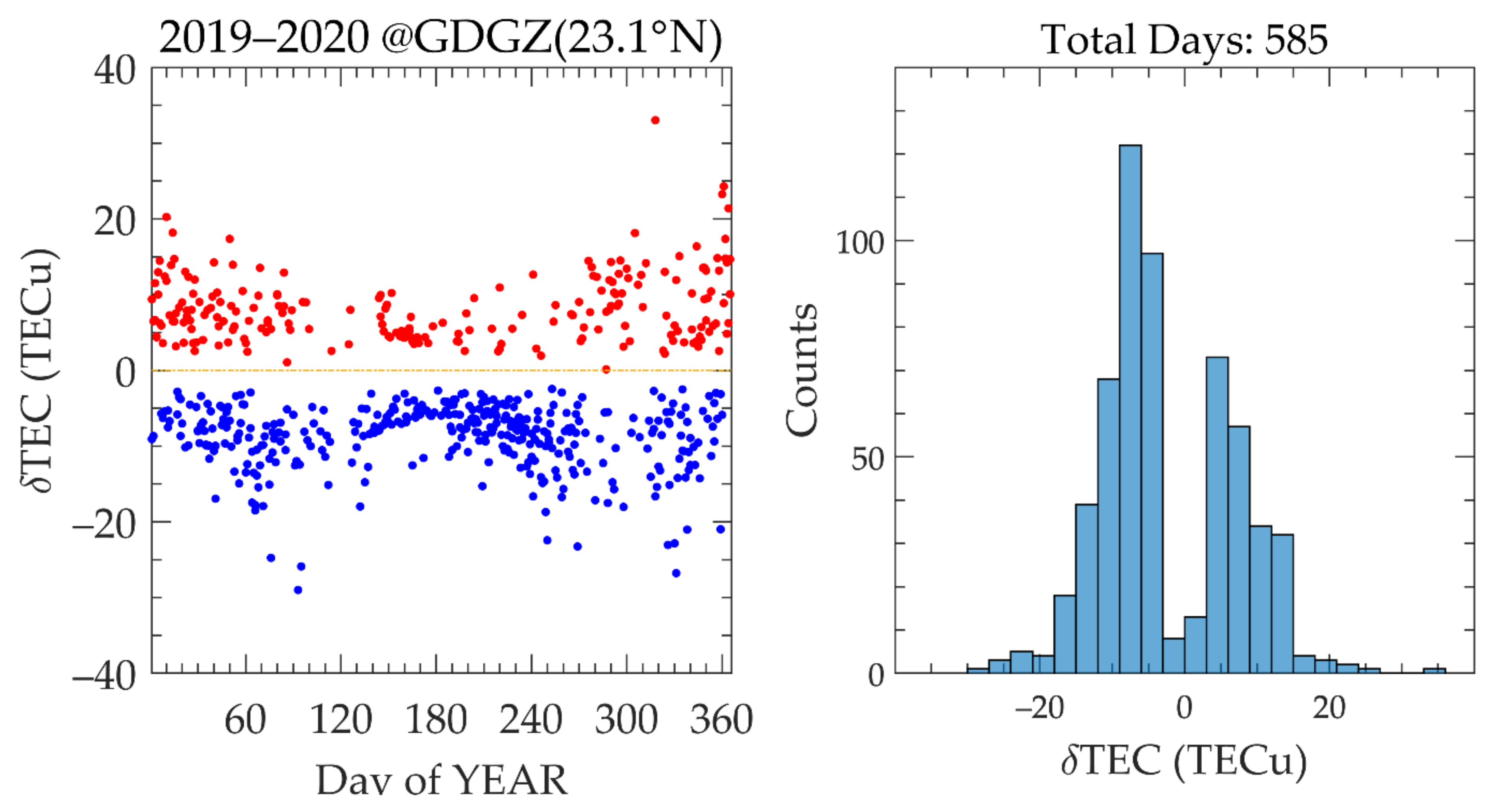
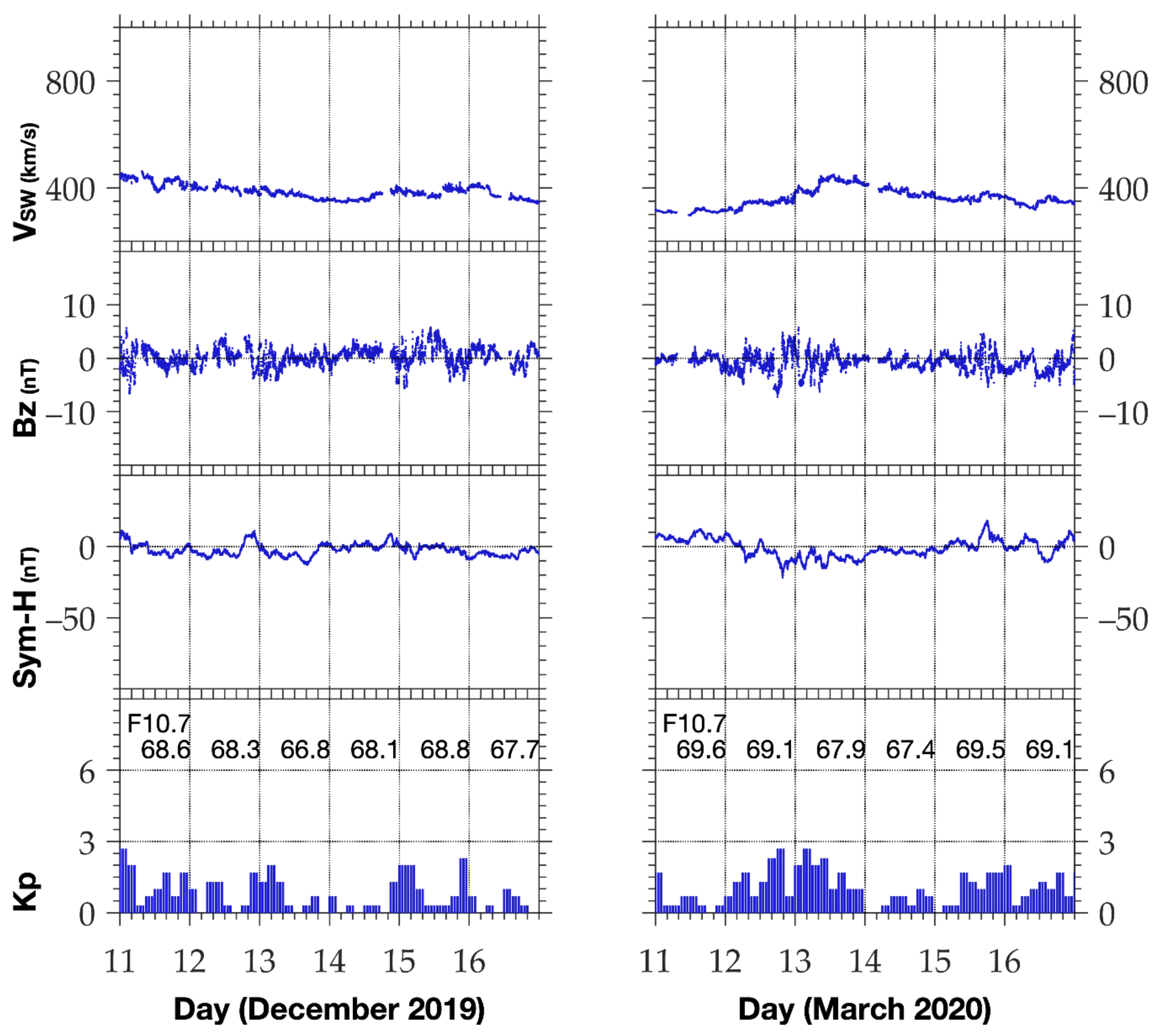
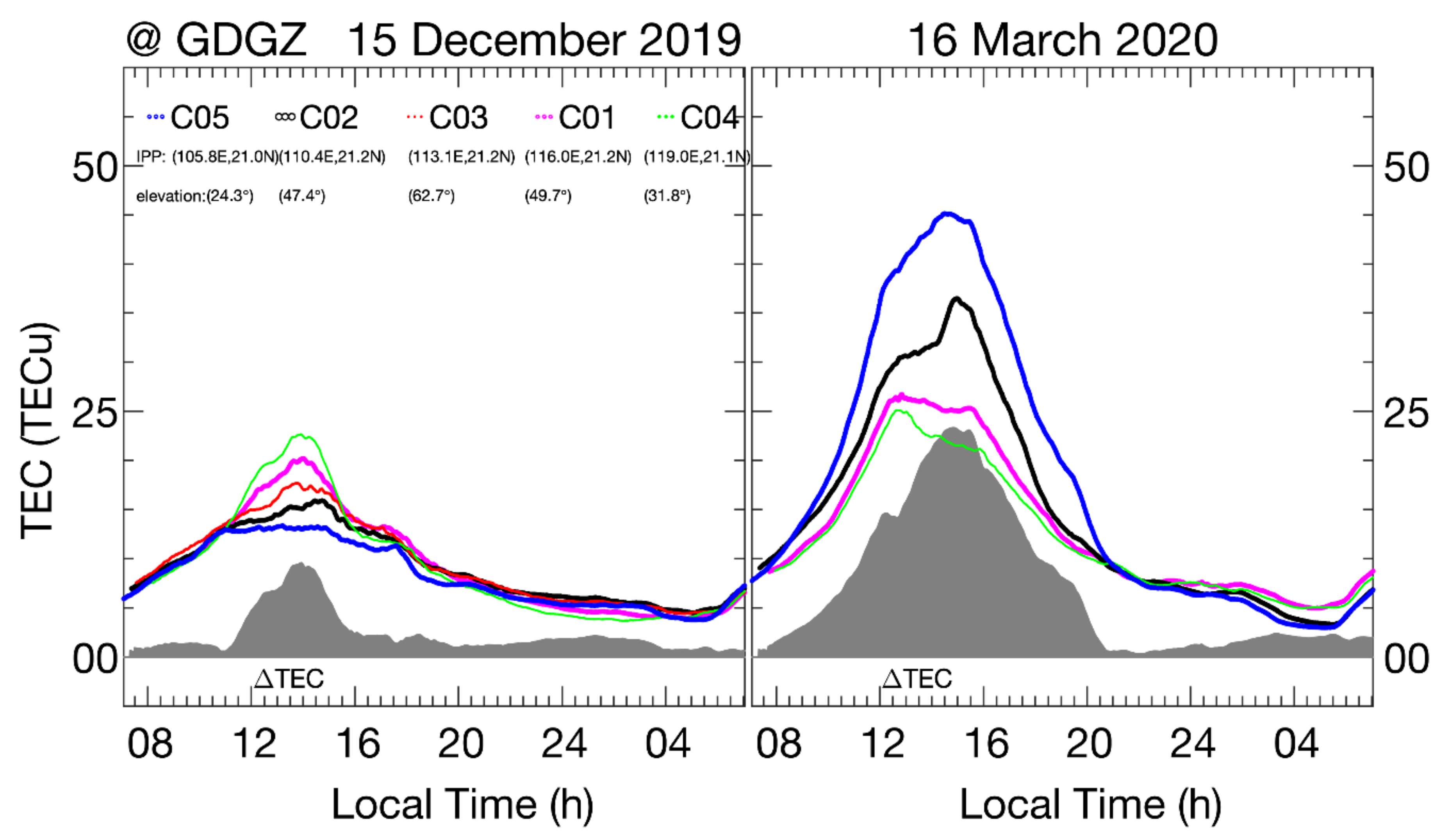
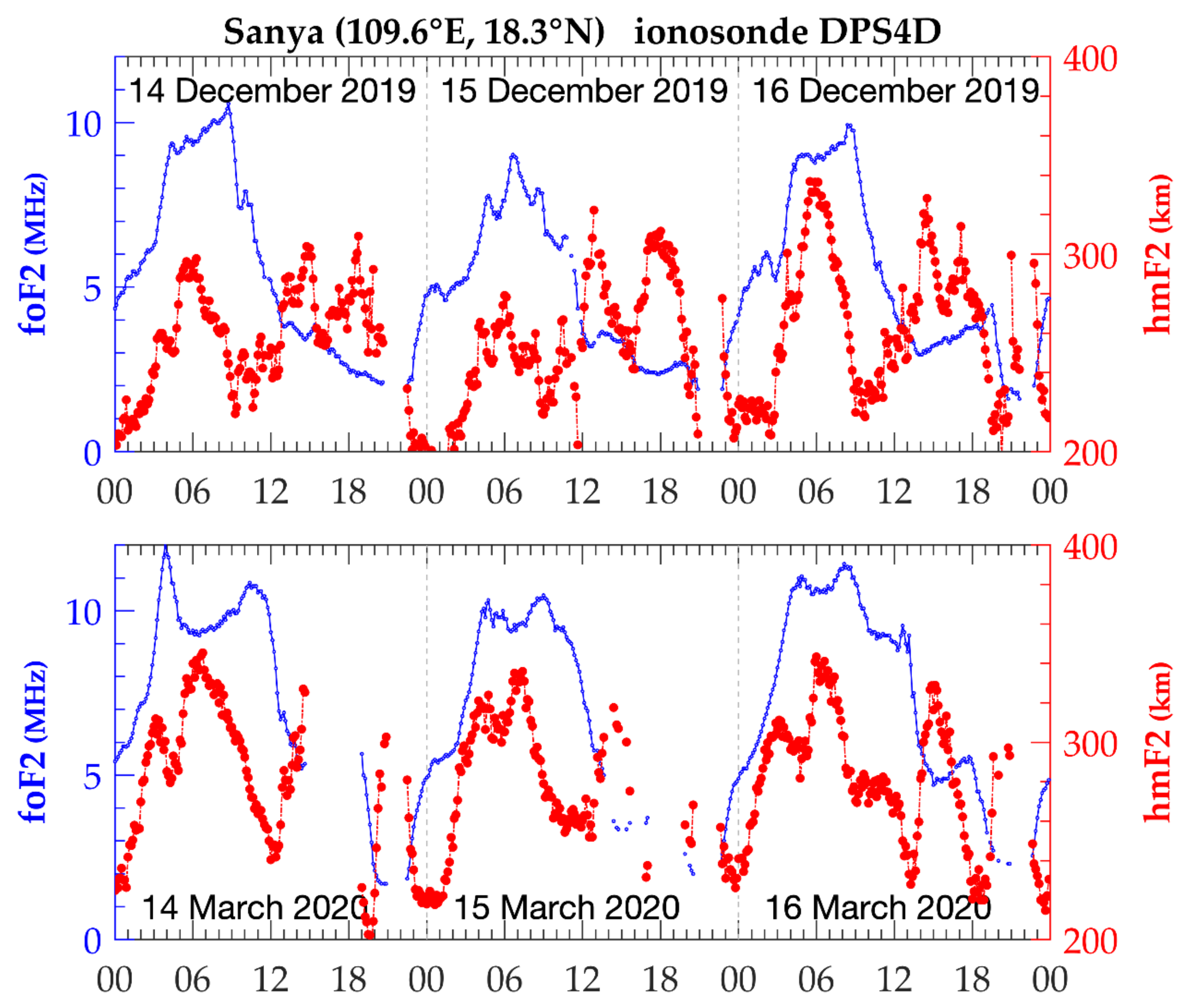

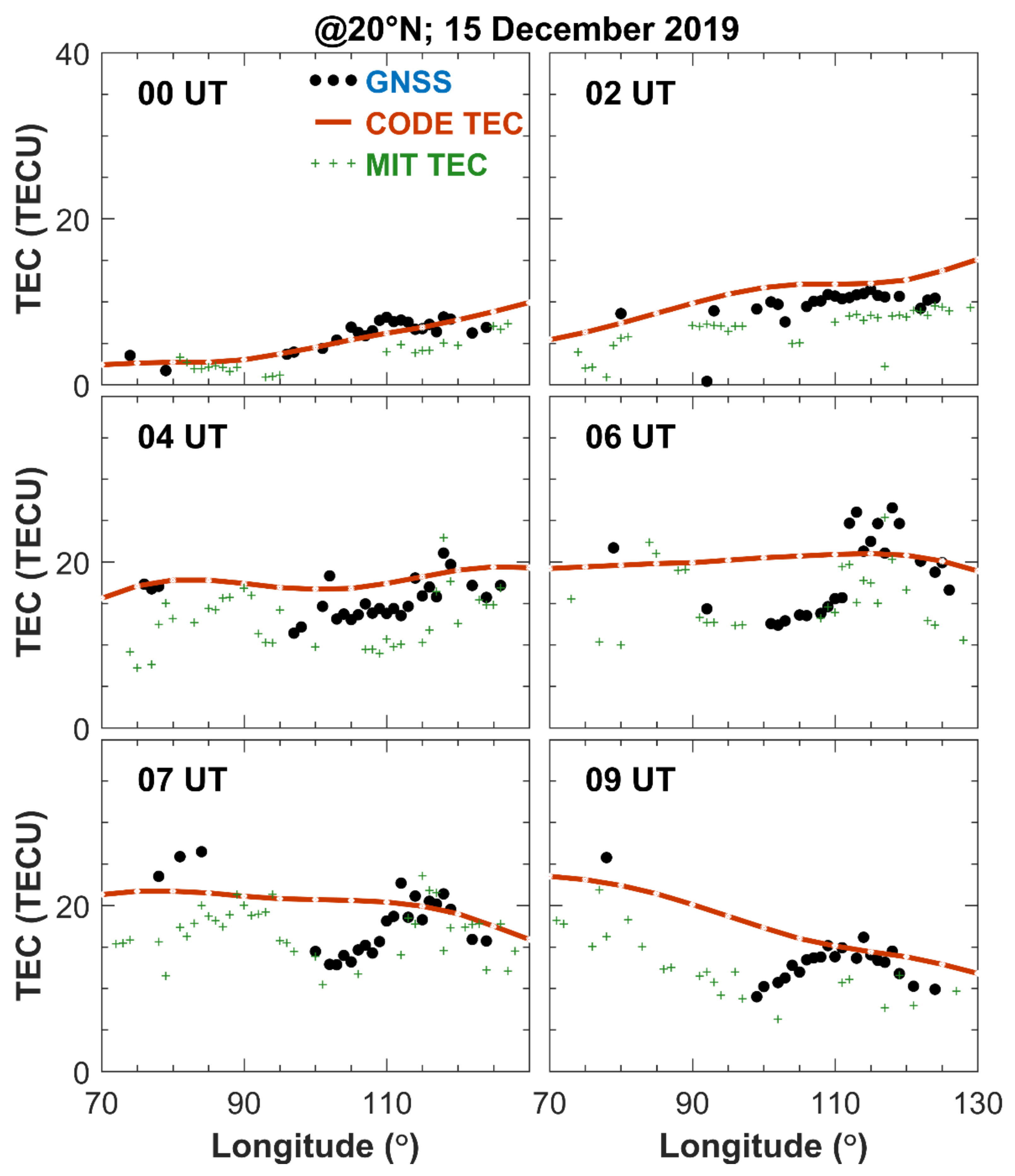

Publisher’s Note: MDPI stays neutral with regard to jurisdictional claims in published maps and institutional affiliations. |
© 2022 by the authors. Licensee MDPI, Basel, Switzerland. This article is an open access article distributed under the terms and conditions of the Creative Commons Attribution (CC BY) license (https://creativecommons.org/licenses/by/4.0/).
Share and Cite
Liu, L.; Yang, Y.; Le, H.; Chen, Y.; Zhang, R.; Zhang, H.; Sun, W.; Li, G. Unexpected Regional Zonal Structures in Low Latitude Ionosphere Call for a High Longitudinal Resolution of the Global Ionospheric Maps. Remote Sens. 2022, 14, 2315. https://doi.org/10.3390/rs14102315
Liu L, Yang Y, Le H, Chen Y, Zhang R, Zhang H, Sun W, Li G. Unexpected Regional Zonal Structures in Low Latitude Ionosphere Call for a High Longitudinal Resolution of the Global Ionospheric Maps. Remote Sensing. 2022; 14(10):2315. https://doi.org/10.3390/rs14102315
Chicago/Turabian StyleLiu, Libo, Yuyan Yang, Huijun Le, Yiding Chen, Ruilong Zhang, Hui Zhang, Wenjie Sun, and Guozhu Li. 2022. "Unexpected Regional Zonal Structures in Low Latitude Ionosphere Call for a High Longitudinal Resolution of the Global Ionospheric Maps" Remote Sensing 14, no. 10: 2315. https://doi.org/10.3390/rs14102315
APA StyleLiu, L., Yang, Y., Le, H., Chen, Y., Zhang, R., Zhang, H., Sun, W., & Li, G. (2022). Unexpected Regional Zonal Structures in Low Latitude Ionosphere Call for a High Longitudinal Resolution of the Global Ionospheric Maps. Remote Sensing, 14(10), 2315. https://doi.org/10.3390/rs14102315







